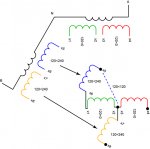I've been thinking of an analogy that would help some understand my view of this single phase circuit that might make sense to others, I just wish I had a way to make a animated graphic of it that would be so much clearer, but I don't have the right programs on this computer so here it goes:
we have a one way street that runs from point A to point B West to East called Winding, at the halfway point is another street that Tee's into Winding from the south called Common and is a two way street, at the bottom of Common it Tee's again, going West is a one way street called Load A, coming from the East east is a one way street called Load B, Load A street is a one way going West and north that returns back to point A of Winding, Load B street is a one way coming from point B on Winding going south then west to the Tee with common.
Now we have our little map we need vehicles, lets call these vehicles Electrons.
Now if I stand at point A looking East down Winding toward point B, I can see all the Electrons going away from me some going all the way to point B and some going as far as Common making a right hand turn to go south, also I can see Electrons coming up Common making a right turn at winding going East to point B then turning back south so from my view all electrons on Winding are travailing from West to East and officer Rick is sitting right there making sure they go in this direction only or there will be a crash.
Now I move to the intersection of Winding and Common, if I look West I have Electrons coming at me and if I look East I have Electrons going away from me, I get confused thinking wow their going two different directions, but I notice officer Rick hasn't pulled anyone over and there isn't any crashes so I move down to point B and look West back up Winding, I'm relived to see that all the Electrons are in fact going only in one direction now I move to common and see that some Electrons are going north and some south and when the Electrons are the same amount passing A point that are passing the B point they have to just bypass Common and travel all the way around the outside of the whole course, but if one extra Electron passes the B point than the A point then a Electron has to turn from load B to Common to relive the extra traffic or if an extra Electron passes point A a car has to turn from Winding onto Common also to relive the extra traffic.
Ok I'm not very good at writing stuff like this but that is my view and like I said depending from which view point I look from if I look from the intersection of Winding and Common the cars can look as if their going in two different directions but in fact they are travailing in the same direction.
If anyone want to simplify this or make a graphic of it go for it.



